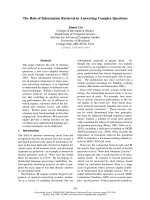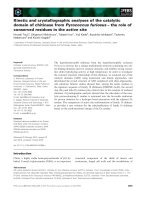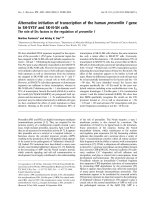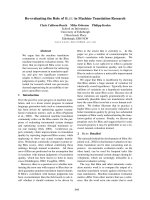THE ROLE OF DNA METHYLATION IN REGULATING LHX3 GENE EXPRESSION
Bạn đang xem bản rút gọn của tài liệu. Xem và tải ngay bản đầy đủ của tài liệu tại đây (1.27 MB, 88 trang )
THE ROLE OF DNA METHYLATION IN REGULATING
LHX3 GENE EXPRESSION
Raleigh Elizabeth Malik
Submitted to the faculty of the University Graduate School
in partial fulfillment of the requirements
for the degree
Doctor of Philosophy
in the Department of Biochemistry and Molecular Biology,
Indiana University
July 2013
Accepted by the Faculty of Indiana University, in partial
fulfillment of the requirements for the degree of Doctor of Philosophy.
____________________________________
Simon J. Rhodes, Ph.D.– Chair
____________________________________
Richard N. Day, Ph.D.
Doctoral Committee
____________________________________
Maureen A. Harrington, Ph.D.
May 14, 2013
____________________________________
Raghu G. Mirmira, M.D., Ph.D.
____________________________________
David G. Skalnik, Ph.D.
ii
Acknowledgments
I would like to acknowledge the members of my graduate committee, Dr. Richard
Day, Dr. Maureen Harrington, Dr. Raghu Mirmira, Dr. Simon Rhodes and Dr. David
Skalnik. I appreciate your guidance and intellectual contributions throughout my graduate
career. I would like to thank Dr. Paul Herring for answering all my questions and helping
me troubleshoot experiments. I would like to thank former Rhodes lab members,
specifically Dr. Kelly Prince, Dr. Soyoung Park and Dr. Chad Hunter. Finally, I would
like to thank members of the Department of Biochemistry and Molecular Biology, as well
as members of the Department of Cellular and Integrative Physiology.
iii
Abstract
Raleigh Elizabeth Malik
THE ROLE OF DNA METHYLATION IN REGULATING
LHX3 GENE EXPRESSION
LIM homeodomain 3 (LHX3) is an important regulator of pituitary and nervous
system development. To date, twelve LHX3 gene mutations have been identified in
patients with combined pituitary hormone deficiency disease (CPHD). Understanding the
molecular mechanisms governing LHX3/Lhx3 gene regulation will provide critical
insights into organ development pathways and associated diseases. DNA methylation has
been implicated in gene regulation in multiple physiological systems. This dissertation
examines the role of DNA methylation in regulating the murine Lhx3 gene. To determine
if demethylation of the Lhx3 gene promoter would induce its expression, murine pre-
somatotrope pituitary cells that do not normally express Lhx3 (Pit-1/0 cells) were treated
with the demethylating reagent, 5-Aza-2’-deoxycytidine. This treatment lead to activation
of the Lhx3 gene and thus suggested that methylation contributes to Lhx3 gene regulation.
Proteins that modify chromatin, such as histone deacetylases (HDACs) have also been
shown to affect DNA methylation patterns and subsequent gene activation. Pit-1/0
pituitary cells treated with a combination of the demethylating reagent and the HDAC
inhibitor, Trichostatin A led to activation of the Lhx3 gene, suggesting crosstalk between
DNA methylation and histone modification processes. To assess DNA methylation
levels, treated and untreated Pit-1/0 genomic DNA were subjected to bisulfite conversion
and sequencing. Treated Pit-1/0 cells had decreased methylation compared to untreated
iv
cells. Chromatin immunoprecipitation assays demonstrated interactions between the
methyl-binding protein, MeCP2 and the Lhx3 promoter regions in the Pit-1/0 cell line.
Overall, the study demonstrates that DNA methylation patterns of the Lhx3 gene are
associated with its expression status.
Simon J. Rhodes, Ph.D.– Chair
v
Table of Contents
List of Figures viii
Abbreviations ix
Introduction 1
1. The Pituitary Gland 1
1.1 Pituitary organogenesis 2
1.2 Pituitary transcription factors 2
1.2.1 PIT-1 2
1.2.2 LHX3 5
2. LHX3 and Combined Pituitary Hormone Deficiency Disease 8
2.1 LHX3 T194R 9
2.2 LHX3 W224Ter 10
3. Epigenetics 11
3.1 Chromatin structure 11
3.2 Histone modifications 12
3.2.1 Interactions of the LHX3 C-terminus with the chromatin regulating
complex, Inhibitor of Histone Acetyltransferase (INHAT) 16
3.3 DNA methylation 18
3.3.1 Methyl CpG binding proteins 19
3.4 MeCP2 and chromatin crosstalk 21
4. Focus of Dissertation 23
Methods 31
1. Bioinformatic Analysis 31
vi
2. Cell Culture 31
3. Cell Culture Treatments 31
4. Bisulfite Sequencing 32
5. RNA Isolation and Reverse Transcription 33
6. Protein Analysis 34
6.1 Protein isolation 34
6.2 Western blot 34
7. Chromatin Immunoprecipitation Assay 35
Results 38
1. Analysis of Lhx3 mRNA and LHX3 Protein Expression 38
2. Identification and Investigation of Methylated Regions in Lhx3 Promoters 38
3. 5-Aza-2’-deoxycitidine Induces Lhx3 Gene Expression 39
4. Trichostatin A and 5-aza-dc Treatment Induce Lhx3 Expression 40
5. Inhibitor treatment did not induce αGSU or TSHβ gene expression 40
6. The Methyl-Binding Protein, MeCP2 Occupies Lhx3 Promoters 41
Discussion 52
References 62
Curriculum Vitae
vii
List of Figures
Figure 1. Transcription cascade governing anterior pituitary development 25
Figure 2. The LHX3 gene 26
Figure 3. LHX3 functional domains 27
Figure 4. Biochemical analysis of T194R mutant 28
Figure 5. Lhx3
W227ter/W227ter
mice are dwarfed and have a PRL deficiency 29
Figure 6. Characterization of the LHX3-INHAT relationship 30
Figure 7. Lhx3 mRNA and LHX3 protein expression in Pit-1/Triple and
Pit-1/0 cells 43
Figure 8. Lhx3a promoter and its methylation pattern 44
Figure 9. Lhx3b and its methylation pattern 45
Figure 10. Lhx3 gene expression changes after treatment with 5-aza-dc in
Pit-1/0 cells 46
Figure 11. Bisulfite sequencing of the Lhx3 promoter post 5-aza-treatment 47
Figure 12. Lhx3 gene expression level varies with concentration of
5-aza-dc plus TSA 48
Figure 13. Lhx3 gene expression is activated after treatment with 5-aza-dc plus TSA in
Pit-1/0 cells 49
Figure 14. αGSU and TSHβ transcripts are not expressed in treated Pit-1/0 cells 50
Figure 15. MeCP2 binds the Lhx3 gene promoters in Pit-1/0 cells 51
viii
Abbreviations
5-aza-dc 5-Aza-2’-deoxycytidine
ACTH adrenocorticotrophic hormone
BAC bacterial artificial chromosome
BDNF brain-derived neurotropic factor
BMP bone morphogenetic protein
BTB/POZ broad complex, tramtrak, bric à brac/pox virus and zinc finger domain
CBP 3’-5’-cyclic adenosine monophosphate response binding element -binding
protein
CpG cytosine-phosphate bond-guanine
CPHD combined pituitary hormone deficiency disease
CRE 3’-5’-cyclic adenosine monophosphate response element
DNMT deoxyribonucleic acid methyltransferases
FGF fibroblast growth factor
FSH follicle-stimulating hormone
GH growth hormone
Glut 3 glucose transporter 3
GNAT Gcn-5-related N-acetyltransferase
GnRH-R gonadotropin-releasing hormone receptor
GR glucocorticoid receptor
GST glutathione S-transferase
HAT histone acetyltransferases
HDAC histone deacetlyase
INHAT inhibitor of histone acetyltransferase
ii
ISL1 islet 1
LANP leucine-rich acidic nuclear protein
LH luteinizing hormone
LHX3 LIM homoeodomain 3
LHX4 LIM homoedomain 4
LIM Lin11,Isl-1, Mec-3
MBD methyl-CpG binding domain protein
MBP methyl CpG binding protein
MYST MOZ, Ybf2-sas3, Sas3 and Tip60
NaCh II type II sodium channel
NF1 nuclear factor 1
PCAF CREB-binding protein associate factor
PGBE pituitary glycoprotein binding element
PIT-1 pituitary-specific transcriptional factor-1
PITX1 pituitary homeobox 1
POMC proopiomelanocortin
PRL prolactin
PRMT protein arginine methyltransferases
PROP-1 prophet of Pit-1
SET Su(var) 3-9,Enhancer of zeste [e(z)], and Trithorax
SP1 specificity protein 1
SUMO small ubiquitin modifier
TAF-1β template activating factor
iii
Tag T-antigen oncoprotein
TRH thyrotropin- releasing hormone
TSA trichostatin A
TSH thyroid-stimulating hormone
αGSU alpha-glycoprotein subunit
iv
INTRODUCTION
1. The Anterior Pituitary Gland
The anterior pituitary gland regulates biological processes such as metabolism,
growth, lactation, reproduction and stress. It controls these physiological and
developmental events by producing hormones from five different hormone-secreting cell
types—corticotropes, gonadotropes, thyrotropes, somatotropes and lactotropes. The
corticotropes produce adrenocorticotropic hormone (ACTH) to regulate the stress
response. ACTH is formed from the proteolytic cleavage of a precursor protein,
proopiomelanocortin (POMC) (Stevens and White, 2010). Gonadotropes produce
follicle-stimulating hormone (FSH) and luteinizing hormone (LH) to regulate
reproduction, while thyrotropes produce thyroid-stimulating hormone (TSH) to regulate
metabolism. FSH, LH and TSH are heterodimeric proteins composed of a common
subunit, alpha-glycoprotein (αGSU) and a specific beta subunit (FSHβ, LHβ and TSHβ)
(reviewed by (Savage et al., 2003; Zhu et al., 2007)). Somatotropes produce growth
hormone (GH) to regulate growth. In humans, there is a cluster of five GH-related genes
in which the most 5′ gene (hGH-N or GH1) is transcribed exclusively in somatotropes
and lactosomatotropes of the anterior pituitary, which produce the pituitary GH protein
(Savage et al., 2003; Baumann, 2009). Lactotropes produce prolactin (PRL) to regulate
lactation and the human prolactin locus consists of a single gene driven by two
promoters—a pituitary-specific promoter and an alternative promoter which drives
expression in non-pituitary tissues (Featherstone et al., 2012).
1
1.1 Pituitary organogenesis
The pituitary relays signals between the hypothalamus and peripheral target
organs (Zhu et al., 2007). The pituitary, located in the sella turcica of the sphenoid bone
at the base of the brain, is composed of two distinct parts that are derived from two
separate embryological sources (Savage et al., 2003; Kelberman et al., 2009). The
adenohypophysis, comprising the anterior and intermediate lobes, arises from the oral
ectoderm-derived Rathke’s pouch, while the neurohypophysis, also known as the
posterior lobe, arises from the neural-derived infundibulum of the diencephalon.
Inductive signaling between the diencephalon and Rathke’s pouch initiates a transcription
factor cascade leading to the development of a mature anterior pituitary, which contains
the five distinct hormone-secreting cell types (Figure 1). In this process, the diencephalon
signaling factors, including the key factors bone morphogenetic protein (BMP) 4 and
fibroblast growth factor (FGF) 8 induce the expression of the LIN11, ISL1, MEC3
(LIM)-homeodomain 3 (LHX3) and the LIM-homeodomain 4 (LHX4) transcription
factors that are essential for the development of a rudimentary Rathke’s pouch and
subsequent pituitary development (Hunter and Rhodes, 2005; Alatzoglou et al., 2009).
1.2 Pituitary transcription factors
1.2.1 PIT-1
Pituitary-specific transcription factor-1 (PIT-1, also known as POU1F1) plays a
critical role in somatotrope, lactotrope and thyrotrope cell development. It regulates
genes such as Gh, Prl, Tsh
β
, growth hormone-releasing hormone (Ghrh) receptor and
thyroid hormone receptor beta type 2 and its own gene through autoregulation (Andersen
and Rosenfeld, 1994; Rhodes et al., 1996). The vital role of the PIT-1 in pituitary
2
development is exemplified in the Snell (dw) and Jackson (dw
j
) mouse models, which
show thyrotrope, somatotrope and lactotrope cell deficiencies (Li et al., 1990). The Snell
mouse dw phenotype occurs as a result of a Pit-1 gene mutation (Li et al., 1990; Fang et
al., 2011). The mutation alters a conserved amino acid in the DNA-binding POU
homeodomain of the transcription factor, ultimately preventing PIT-1 from binding key
regulatory regions of anterior pituitary target genes (Li et al., 1990). The other mouse
model, known as the Jackson dwarf mouse, carries an inactivating Pit-1 gene
rearrangement (Li et al., 1990). The resulting dw
j
phenotype is similar to the Snell
phenotype showing deficiencies in GH, TSH and PRL and to human diseases featuring
PIT-1 gene mutations, suggesting that PIT-1 is a critical regulator of human pituitary
gene functions (Li et al., 1990; Pfaffle and Klammt, 2011).
The regulation of the Pit-1gene and PIT-1 structure
The Pit-1/POU1F1 gene is well characterized in rodents and humans and its gene
expression is restricted to the caudomedial region of the pituitary gland (Zhu et al., 2007).
In rodents, the Pit-1 proximal promoter is a 300 bp region surrounding the transcription
start site. It contains a TATA box, two cyclic AMP response elements (CREs) in the rat
or one CRE in the mouse and two autoregulatory PIT-1 binding sites. The positive PIT-1
autoregulatory site is upstream, while a negative site is downstream and position
dependent (McCormick et al., 1990; de la Hoya et al., 1998). The rodent Pit-1 gene also
has a distal enhancer containing additional PIT-1 autoregulatory binding sites, a vitamin
D receptor element, a PIT-1 retinoic acid response element and a putative Prophet of Pit-
1 (PROP-1) binding site (Rhodes et al., 1993; DiMattia et al., 1997; de la Hoya et al.,
1998).
3
The human PIT-1 minimal promoter spans nucleotides -102 to +15 relative to the
Pit-1 transcription start site, and contains an autoregulatory PIT-1 binding element as
well as additional cis elements that confer high basal transcriptional activity (Delhase et
al., 1996). Unlike the rodent promoter sequence, the human proximal and distal
promoters do not contain a CRE (de la Hoya et al., 1998). Additionally, the distal
promoter region contains autoregulatory binding sites, but does not show interaction with
the minimal promoter (Delhase et al., 1996). Expression of the human PIT-1 gene is also
down regulated by the OCT-1 and AP-1 transcription factors (Delhase et al., 1996).
PIT-1 belongs to the POU homeodomain family. The protein is comprised of an
amino (N-) terminal activation domain and two domains responsible for high affinity
DNA binding: a POU-specific domain that is located closer to the N-terminus and a
carboxyl (C-)terminal POU homeodomain. The PIT-1 protein recognizes AT-rich
nucleotide sequences in the pituitary-expressed GH, PRL and TSHβ promoters (Kerr et
al., 2008)
Pit-1 lineage cell lines
Recently, Sizova and colleagues characterized three new mouse cell lines
representing PIT-1-associated cell lineages (Sizova et al., 2010). Mouse Pit-1 or GH gene
regulatory sequences (Pit-Tag or GH-Tag) were used to guide expression of the SV40
large T-antigen oncoprotein (Tag) to the developing pituitaries of transgenic mice. Three
cell lines were derived from tumors: Pit-1/0, Pit-1/Triple and Pit-1/Prl and each cell line
represents different phases of PIT-1-dependent cell differentiation in the mouse anterior
pituitary. The Pit-1/0 cell line, established from a pituitary tumor of a 12 week mouse
carrying the Pit-Tag transgene and the hGH/bacterial artificial chromosome (BAC)
4
transgene, represents an initial stage of somato-lacto-thyrotropic differentiation. The Pit-
1 gene is expressed, but the cells fail to express the PIT-1-dependent hormones: GH, PRL
and TSHβ. The Pit-1/Triple cell line, established from a 20 week mouse carrying a Pit-
Tag induced pituitary tumor, represents a more differentiated Pit-1 lineage cell line.
These cells express PIT-1 protein and its target genes, Gh, Prl and Tshβ. The third cell
line, the Pit-1/Prl cells were harvested from the pituitary tumor of a mouse carrying both
the GH-Tag and hGH/BAC transgene. The cells express PIT-1 and Prl, but not GH or
TSHβ. These PIT-1 lineage cell lines are valuable tools to understand the intermediate
stages of anterior pituitary development, including epigenetic changes that dictate
pituitary gene expression.
1.2.2 LHX3
LHX3 (also known as LIM3 or P-Lim) plays a key role in anterior pituitary
organogenesis, as well as nervous system development (Seidah et al., 1994; Bach et al.,
1995; Zhadanov et al., 1995). In the pituitary, LHX3 is required for the formation of
somatotropes, thyrotropes, gonadotropes and lactotropes, four of the five distinct
hormone-secreting cell types. LHX3 activates the transcription of hormone genes, such as
the αGSU, PRL, FSHβ and gonadotropin-releasing hormone receptor (GnRH-R), as well
as the PIT-1 transcription factor genes (Savage et al., 2003; Zhu et al., 2007). LHX3
binds the pituitary glycoprotein binding element (PGBE) of the αGSU gene to activate its
transcription. In the nervous system, LHX3 interacts with key proteins to establish motor
neuron and interneuron identity. Interaction between LHX3 and the NLI LIM cofactor is
associated with V2 interneuron differentiation, while motor neuron development requires
LHX3 interaction with Islet 1 (ISL1) (Thaler et al., 2002). The critical role that LHX3
5
plays in nervous system and pituitary development is demonstrated by the phenotype of
Lhx3 gene knockout mice (Lhx3
-/-
) which die at birth (Sheng et al., 1996). The Lhx3
-/-
mice lack correctly formed anterior and intermediate pituitary lobes, and four of the five
differentiated hormone-secreting anterior cell types are absent, with only a small
population of corticotropes remaining (Sheng et al., 1996). Homozygous Lhx3 knockout
mice also do not undergo proper motor neuron specification (Sheng et al., 1996; Sharma
et al., 1998).
The regulation of the Lhx3 gene and LHX3 structure
The Lhx3 gene, comprising seven exons and six introns (Figure 2), produces two
mRNA transcripts: Lhx3a and Lhx3b. The Lhx3 gene contains two TATA-less, GC rich
promoters that initiate the transcription of Lhx3a and Lhx3b mRNAs. Basal gene activity
is mediated by the 2 kb and 1.8 kb Lhx3a and Lhx3b promoters, respectively (Yaden et
al., 2006). The LHX3 promoters contain both nuclear factor 1 (NF1) and specificity
protein 1 (SP1) transcription factor binding sites and both factors regulate LHX3
transcription (Yaden et al., 2006). Recently, it has also been shown that SOX2, a
developmental transcription factor, can bind and activate the human LHX3a promoter
(Rajab et al., 2008; Alatzoglou et al., 2009).
In the human LHX3 gene, a distal enhancer confers some aspects of spatial and
temporal LHX3 expression in the pituitary and nervous system. A defined 180 bp core
region (Core R3) of this enhancer guides pituitary-specific expression in model
transgenes (Mullen et al., 2012). Pituitary Core R3 enhancer activity involves the binding
of the ISL1 LIM-homeodomain transcription factor, and the pituitary homeobox 1
6
(PITX1) transcription factor, as demonstrated by chromatin immunoprecipitation assays
and mutation of transgenes (Mullen et al., 2012).
The LHX3 transcripts are translated to two major protein isoforms, LHX3a and
LHX3b (Sloop et al., 1999). Each LHX3 isoform possesses distinct DNA binding and
promoter activation activities (Sloop et al., 1999; Sloop et al., 2001). The LHX3a and
LHX3b isoforms result from translation of the first methionine codon of the respective
mRNA (Sloop et al., 1999). The LHX3 protein isoforms have specific domains that exert
their functions (Figure 3) (Sloop et al., 1999; Parker et al., 2000; Sloop et al., 2001;
Parker et al., 2005). Both the LHX3 protein isoforms contain a DNA-binding
homeodomain, two LIM domains, which participate in protein-protein interactions, and a
carboxyl terminus (C-terminus) trans-activation domain. The DNA-binding
homeodomain also contains nuclear localization signals that target LHX3 to the nuclear
matrix (Sloop et al., 1999; Parker et al., 2000). The C-terminus of the LHX3 isoforms is
divided into three regions, C1, C2 and C3 (Figure 3). The C1 domain contains a nuclear
localization signal and multiple phosphorylation sites (Parker et al., 2005). LHX3 is a
predicted substrate of protein kinase C and casein kinase II, and overexpression of these
kinases leads to a decrease in activation of LHX3 target genes. The C2 region contains a
trans-activation domain site important for synergy with PIT-1 to activate target
promoters, such as those of the prolactin and Tshβ genes (Bach et al., 1995; Sloop et al.,
1999; Sloop et al., 2001). The function of the C3 domain has yet to be elucidated.
The LHX3a isoform acts as a transcriptional activator, while the LHX3b isoform is a
poor activator of gene transcription and may serve as a repressor (Sloop et al., 1999).
7
A third protein isoform, M2-LHX3, can be formed by preferential translation of
the second in-frame methionine codon of the LHX3a mRNA, and is primarily made up of
the homeodomain plus the C-terminus activation domain (Sloop et al., 2001). Like
LHX3a, M2-LHX3 can induce transcription of the PRL, αGSU, FSHβ and TSHβ genes
(Sloop et al., 2001; West et al., 2004).
2. LHX3 and Combined Pituitary Hormone Deficiency Disease
Mutations and gene deletions in human pituitary transcription factor genes have
been implicated in the etiology of hormone deficiency diseases. Genetic changes
affecting anterior pituitary transcription factors often lead to negative downstream
effects, including loss of multiple hormones (Pfaffle and Klammt, 2011). Combined
pituitary hormone deficiency (CPHD) disease is diagnosed by the insufficiency of GH
and one or more anterior pituitary hormones (Pfaffle and Klammt, 2011). CPHD patients
are usually diagnosed as children due to the developmental nature of the affected
transcription factor(s). Although rare, recessive mutations in LHX3 are responsible for
some CPHD diagnoses. To date, twelve recessive LHX3 mutations have been molecularly
and clinically identified as associated with CPHD (Netchine et al., 2000; Bhangoo et al.,
2006; Pfaeffle et al., 2007; Rajab et al., 2008; Kristrom et al., 2009; Bonfig et al., 2011;
Colvin et al., 2011; Bechtold-Dalla Pozza et al., 2012). Patients with recessive LHX3
mutations have deficiencies in GH, PRL, TSH, FSH and LH. As a result of the hormone
loss, patients may exhibit shortness of stature, metabolic defects and delayed/failed
puberty. Other symptoms may include a hypoplastic, normal or enlarged anterior
pituitary structure, rigid spine, hearing loss, and ACTH deficiency. Two interesting LHX3
mutations, T194R and W224Ter, provide insight into the DNA-binding properties and
8
functional domains of the protein, respectively (Pfaeffle et al., 2007; Bechtold-Dalla
Pozza et al., 2012). Understanding the molecular mechanisms associated with CPHD may
provide pathways to potential therapies and treatments for patients, while enhancing our
knowledge of pituitary function.
2.1 LHX3 T194R
Two sibling pediatric patients with CPHD presented with neonatal complications
and one patient died 20 days after birth due to cardiorespiratory insufficiency. The
surviving patient presented with sensorineural hearing defect (nervous system
deficiency), as well as loss of GH, LH, FSH, TSH and PRL, with a later onset of ACTH
deficiency (pituitary defect). The patients had a homozygous mutation in LHX3 that
resulted in an amino acid substitution (Bechtold-Dalla Pozza et al., 2012). For each
patient, sequencing of the LHX3 gene identified a homozygous C→G transversion in the
fourth coding exon. The transversion changed amino acid 194 from threonine to arginine
(T194R) in the DNA-binding homeodomain. Sequence analyses demonstrated that the
threonine residue was conserved among the LHX3/ LIMs proteins of various species, as
well as in the corresponding position in other human LIM-homeodomain proteins.
Computer modeling predicated that the T194R substitution would lead to steric
hindrances, mainly with glutamine 170 and leucine 172, suggesting that the steric
hindrances may destabilize the tertiary structure of the DNA-binding homeodomain.
Electrophoretic mobility shift assays (EMSA) showed that LHX3 T194 fails to bind
known LHX3 target sequences, and the LHX3 T194R did not activate luciferase reporter
genes under the control of the αGSU and Prl gene promoters (Figure 4).
9
The T194R mutation is of particular interest because it represents the major class
of LHX3 mutations in that it affects both pituitary and nervous system development.
However, one identified LHX3 mutation, W224Ter, is described to only affect pituitary
development (Pfaeffle et al., 2007).
2.2 LHX3 W224Ter
The LHX3 W224Ter mutation was identified in four siblings of a consanguineous
Lebanese family (Pfaeffle et al., 2007). The patients presented with pituitary hormone
deficiency but without the typical cervical spine rigidity that is thought to result from loss
of LHX3 action in the nervous system. This phenotype therefore is unlike other LHX3
mutation patients who have both pituitary and nervous system defects. This LHX3
mutation was result of a G→A transition in position 672 of the LHX3a open reading
frame, introducing a premature stop codon predicted to cause loss the of the C-terminus
of the LHX3 protein (Pfaeffle et al., 2007). As described above, the LHX3 C-terminus
contains trans-activation domains that are critical for pituitary gene regulation (Bach et
al., 1995; Parker et al., 2000; Sloop et al., 2001) so it is consistent that loss of this protein
region would lead to pituitary defects. A mouse model of the human LHX3 W224Ter
disease (Lhx3 W227Ter) was created to determine the molecular and cellular outcomes
from this mutation (Colvin et al., 2011). Similar to the patients, the mice displayed
dwarfism, reduced body weight and hypothyroidism (Figure 5). Although patients with
the W224Ter mutation had reduced FSH, LH and PRL, their inherent reproductive
potential was unknown due to the necessity of hormone therapy at an early age. The
female W227Ter mice exhibited infertility, with marked deficiencies in LH, FSH and
PRL (Figure 5). The phenotype of the Lhx3 W227Ter mouse model demonstrates that the
10
molecular actions of LHX3 in the pituitary and nervous system are separable in vivo, as
well as confirming the role of the LHX3 C-terminus in pituitary development.
To further understand the critical role of the LHX3 C-terminus in pituitary gene
transcription, our lab performed an affinity purification screen to identify proteins that
interact with the C-terminus. Results from the screen indicated that chromatin-regulating
proteins interact with the LHX3 C-terminus. However, a general understanding of
epigenetics is necessary to further define both the interaction of the LHX3 C-terminus
with the chromatin regulators, as well as regulation of the Lhx3 gene.
3. Epigenetics
Epigenetics can be defined in various ways, depending on the context. Here, it is
defined as “the structural adaptation of chromosomal regions so as to register, signal or
perpetuate altered activity states” (Bird, 2007). This definition, presented by British
geneticist, Dr. Adrian Bird in the introduction of the May 2007 Nature Insight
Epigenetics issue, aims to unify multiple epigenetic events that occur in a cell.
3.1 Chromatin structure
Genomic DNA is packaged with histone proteins to form chromatin. In the
canonical model, nucleosomes, the basic unit of chromatin are composed of ~147 bp of
DNA wrapped around a histone octamer composed of two copies each of the histones
H2A, H2B, H3 and H4 (Kornberg and Thomas, 1974; Luger et al., 1997). Electrostatic
interactions and hydrogen bonds between the DNA and histones stabilize nucleosome
structure. Additionally, histones have a flexible tail, which can interact with neighboring
nucleosomes or nuclear factors (Luger and Richmond, 1998). Short DNA segments,
termed linker DNA, connect neighboring nucleosomes to form the primary structure of
11
chromatin, often referred to as “beads-on-a-string” (Oudet et al., 1975; Thoma et al.,
1979; Turner, 2005; Luger et al., 2012). Nucleosomes interact with each other to form
chromatin fibers, and subsequent fiber interactions lead to highly condensed chromatin.
Chromatin is organized into two types of conformations, heterochromatin and
euchromatin (Bassett et al., 2009). Condensed heterochromatin is inaccessible to DNA
binding factors and is usually transcriptionally silent, whereas decondensed euchromatin
is generally accessible and transcriptionally active (reviewed by (Grewal and Moazed,
2003)). Nucleosome modifications, resulting from post-translational modifications of
histones and DNA methylation, provide a mechanism for the regulation of nuclear
processes by providing an explanation of how transcription factors access DNA within
the context of chromatin.
3.2 Histone modifications
Histones are subject to post-translational modifications, chemical modifications of
amino acid side chains (Berger, 2002). Although there are numerous post-translational
modifications, histone tails are most commonly modified by phosphorylation,
SUMOylation, methylation, and acetylation.
Histone phosphorylation is linked to multiple cellular processes, including, but
not limited to chromatin condensation, transcriptional regulation, and apoptosis (Wei et
al., 1998; Goto et al., 1999; Cruickshank et al., 2010; Mahajan et al., 2012; Park and
Kim, 2012). Chromatin phosphorylation has been implicated in chromatin condensation
during the cell cycle. For example, phosphorylation of histone H3 on Ser10 and Ser28
plays a role in mitotic and meiotic chromosome condensation (Wei et al., 1998; Goto et
al., 1999). Histone phosphorylation is also linked to apoptosis as demonstrated by the
12
findings that kinase Cδ phosphorylation of histone H3 on Ser10 occurs when cells have
been exposed to death stimuli (Park and Kim, 2012). An example of histone
phosphorylation affecting transcriptional regulation is demonstrated by the recent work of
Mahajan and colleagues, who showed that phosphorylation of histone H2B at T37 by the
WEE1 kinase leads to the transcriptional suppression of core histone genes (Mahajan et
al., 2012). The cellular functions altered by histone phosphorylation are extensive, yet the
above examples provide a glimpse into the diverse complexities of histone
phosphorylation (Banerjee and Chakravarti, 2011).
Another histone modification is SUMOylation, which occurs when a small
ubiquitin modifier (SUMO) is post-translationally added to proteins. SUMO modification
has been shown to regulate protein-protein interactions by increasing the affinity of
interacting proteins, as well as altering the subcellular localization of modified proteins
(Lomeli and Vazquez, 2011). The addition of the SUMO moiety has also been shown to
protect proteins from ubiquitin-dependent degradation (Melchior, 2000). With regard to
histones, Shiio and Eisenman showed that SUMOylation of histone H4 leads to gene
silencing through the recruitment of histone deacetylase and heterochromatin protein 1
(Shiio and Eisenman, 2003).
A third type of histone modification is methylation, which occurs when histone
methyltransferases target lysine or arginine residues. A family of nine protein arginine
methyltransferases (PRMTs) transfer a methyl group to the arginine residue of histone
proteins, while lysine residues are usually modified by the Su(var)3-9, Enhancer-of-zeste
and Trithorax (SET) domain family of methyltransferases (Berger, 2002). Histone
methylation can either activate or repress gene transcription. For example methylation of
13
histone H3 at lysine 9 (H3K9) can be a marker of gene repression, while methylation of
histone 3 at lysine 4 (H3K4) has been associated with activation of specific genes (Lee et
al., 2005).
Acetylation is a well characterized post-translational histone modification. The
addition of an acetyl group is catalyzed by histone acetyltransferases (HATs). There are
three “superfamilies” of HATs: the GNAT (Gcn5-related N-acetyltransferase), the MYST
(MOZ, Ybf2-sas3, Sas2 and Tip60), and the p300/CREB-binding protein (CBP) families
(Verdone et al., 2006; Graff and Tsai, 2013). In mammals, the GNAT family has
homologues in various organisms and is divided into two subfamilies named the GCN5
acetyltransferases and the p300/CREB-binding associated factors (PCAF) (Verdone et
al., 2006). Both proteins are associated with HAT activity, but PCAF has also been
shown to act as a co-activator in cellular processes, such as nuclear-receptor mediated
activation and hormone promoter regulation (Blanco et al., 1998; Nagy and Tora, 2007;
Wang et al., 2010; Kino and Chrousos, 2011). In the pituitary TSHβ promoter, cyclic
adenosine monophosphate (cAMP) treatment led to increased binding of PCAF and p300
to the promoter, and subsequent increased H4 acetylation, suggesting that recruitment of
the HATs likely caused the observed acetylation (Wang et al., 2010). The p300/CBP
HAT subfamily also has roles in hormone and developmental transcription factor
regulation (Hashimoto et al., 2000; Hashimoto et al., 2005; Miller et al., 2012).
Hashimoto and colleagues demonstrated that after thyrotropin-releasing hormone (TRH)
stimulation, LHX3a and CBP synergistically activated the mouse αGSU gene promoter
(Hashimoto et al., 2005). PIT-1 has also been shown to recruit coactivator complexes
containing CBP/p300 to activate gene transcription (Xu et al., 1998; Zanger et al., 1999).
14









